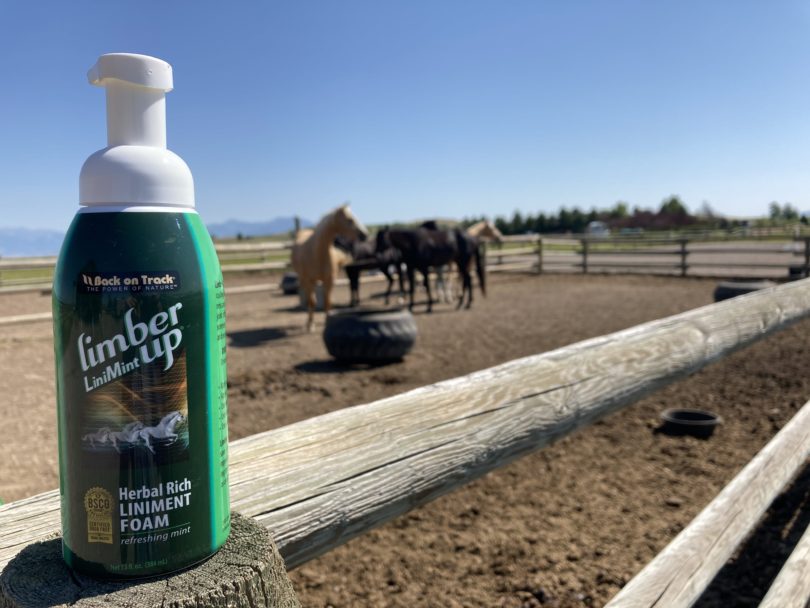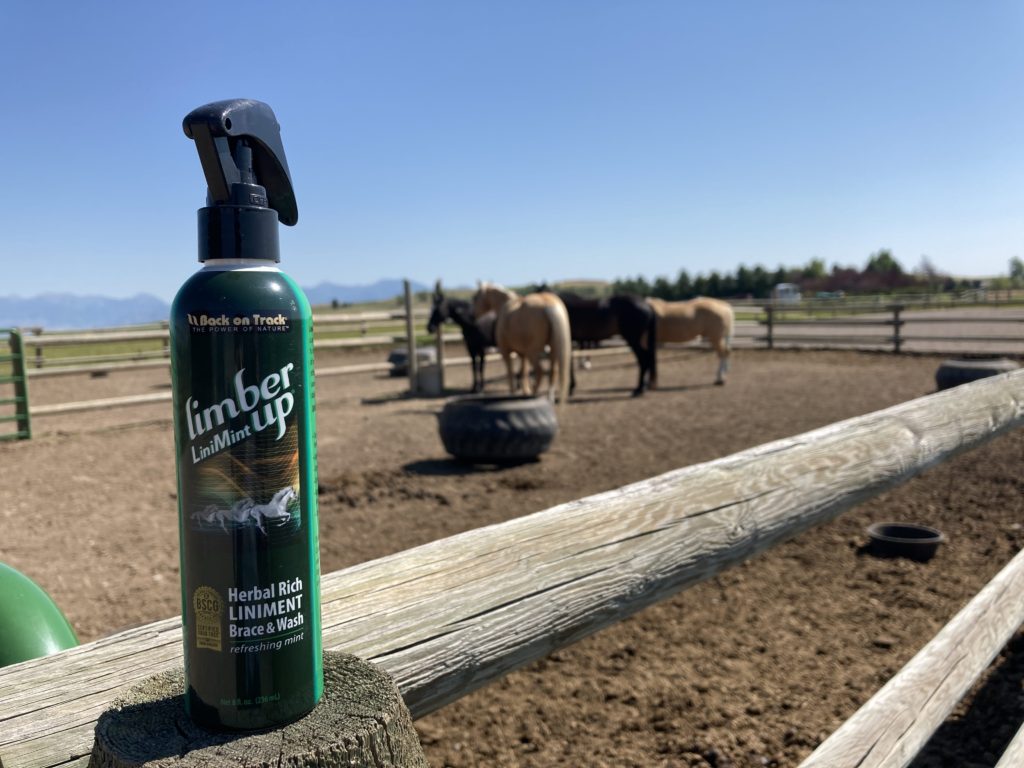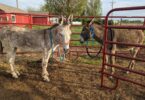Aches and Pains Affect Riders and Their Horses
It has been a productive day. You and your horse were coordinated and you fine-tuned that new exercise together. You’re worn out, and your horse is sweaty and clearly put his heart into the session. Have you ever wondered how you can help your horse after a heavy workout?
Just like humans, horses can feel sore after exercise. Liniment can help a horse recover after using new muscles, or exercising muscle groups harder than normal. Applying liniment helps lessen sore and stiff muscles and prevent inflammation. It also increases circulation, so liniment can also be used to target particularly sore areas by applying it full-strength directly onto a horse’s coat.
Caution: I would avoid open sores since this can cause a stinging sensation.
What are horse liniments?
Liniment is used to soothe muscles and joints in horses and can come in liquid or gel form. Some riders apply liniment only when there is a problem, such as swelling or soreness. Other riders use liniment as a preventative measure. Liniment can be used for a variety of reasons, including:
- To relieve muscle soreness
- To reduce swelling
- To help with pain from arthritis
- To treat certain skin and hoof conditions
- To use as an antiseptic
- To dilute and use as a body wash
There are different types of liniment available in the market; always read the instructions for the product you are using, as they can vary across different brands. For example, Absorbine Liniment says it is safe to use on minor cut.
Other brands, such as Sore No-More, specifically says not to spray it on wounds. It is a good idea to test a new product such as liniment on a small, uninjured area of your horse first to see if there are any negative reactions before using on a larger or affected area.
My stand-by favorite liniment is Vetrolin.
It has been around forever, smells amazing, and you only need a little bit diluted in water for it to be effective. Farnam recommends one ounce of Vetrolin for a quart of warm water for a regular post-workout wash. I just take a feed bucket and splash enough to coat the bottom with ½” of Vetrolin, and fill the bucket the rest of the way with warm water.
Even though the water is warm, the sensation will be cool on the muscles once the solution is applied.

Source: Pixabay
You will want to start by applying it to their lower legs first, then work your way up on one side to the shoulder, across their chest and up their neck. From there, you can move underneath their belly or up towards their back. Repeat on the other side, but I recommend getting all four of their legs first. It gets their body accustomed to the sensation before hitting any major muscles and causing them any shock upon contact.
As a habit, it would be good to at least coat your horse’s legs after every workout, and reserve the full-body wash for the particularly intense workouts.
If you have any left-over (which you probably will), you can store your bucket on the floor of your tack room (a trick I picked up from my trainer) and continue to use the solution until gone.
Applying Vetrolin, or many other liniments, is a kind way to end a session with your mount. It helps them recover from soreness more quickly and feel great the next day. Plus it smells d-i-v-i-n-e!
As always, consult your veterinarian before adding anything to your horse care routine.
Frequently Asked Questions
What does horse liniment smell like?
Horse liniments may smell different depending on their ingredients. Most people would describe liniment as having a medicinal odor; some describe the smell as minty (common if spearmint or peppermint are included in the ingredient list). Liniment could also smell herbal, or like alcohol, as that is another common ingredient.
An herbal scent would be more common in a “natural” liniment. The smell could vary quite a bit depending on which essential oils are utilized. A few examples of different essential oils found in liniment include: Oil of sassafras, oil of spike, oil of cedarwood, oil of rosemary, oil of thyme, and oil of cajuput. Many people seem to enjoy the smell, however, I prefer to apply liniment using gloves so the smell doesn’t linger for the rest of the day.
What ingredients are in horse liniment?
It is always a good idea to review the list of ingredients and directions on anything you buy to feed or apply to your horse. Not all liniments are the same. Horses could have allergies to certain ingredients, which should be avoided.
Some common ingredients across several brands of liniment include:
- Menthol 4.0% or 1.25%
- Witch Hazel
- Alcohol
- Water
- Spearment leaf oil
- Glycerine
- Plant extracts (calendula, echinacea, wormwood)
- Propylene glycol
- Camphor oil of sassafras
- Oil of spike
- Methyl Salicylate
- Salicylic acid
- Oil of cedarwood
- Oil of rosemary
- Oil of thyme
- Methylsulfonylmethane (MSM)
- Oil of cajuput
How often should you apply horse liniment?
The number of recommended liniment applications depends on the product instructions, application purpose, and the user.
Before using, refer to the product instructions—do not exceed the recommended frequency of applications. Next, consider the application purpose.
Absorbine Liniment has antiseptic properties that can be used to kill both bacteria and fungus. When using on hooves, they recommend a once weekly application. If using liniment for skin conditions, the frequency is increased to three recommended treatments per week. Liniment could also be used pre or post-workout; in this case, you may use it as much as daily.
Watch for signs of irritation or discomfort; if your horse exhibits any, discontinue use and consult your veterinarian.
Last, the user determines the application frequency. At my barn, liniment wasn’t used all that often, so I would only use it after particularly hard rides (generally any time we jumped) and after trailering longer distances. Some barns/trainers may not use it at all, others may lean towards a daily/preventative application.
Is it safe for humans to use horse liniment?
It is not recommended to use horse liniment on people. Horse liniment is designed for use on horses and is not tested on people or approved by the FDA for human use. Some people have reported allergic reactions to liniment. Some liniments contain DMSO, a substance that is absorbed through the skin into bloodstream. You should always use gloves when handling anything containing DMSO. There are human-grade versions of liniment; it would be best to use those instead.
P.S. Enjoy this article? Trot on over to:
- Horse Rookie Riding Essentials Amazon List
- The Ultimate Horse Trailer & Packing List
- Horseback Riding in College: Tips from Alyssa Simin
- FLY FREE: 14 Best Horse Fly Sprays (Brand Name and Homemade)
- For a brief non-medical history of liniment use on horses, see Wikipedia.
Sources:
https://www.wfyoung.com/using-absorbine-veterinary-liniment-to-help-treat-a-horses-minor-leg-strain/
https://absorbine.com/products/absorbine-veterinary-liniment
https://www.youtube.com/watch?v=5uUF5nBIav0











[…] Liniment is great for lessening and even preventing stiff muscles the day after a workout for your horse. It does so by improving circulation and bringing down swelling. This is used for muscle injury for those purposes, but I have always used it just after workouts to prevent discomfort in my horse. […]
[…] I get Apple Elite. It works great for helping my horse recover faster after work, and there are 3-4 doses per […]
[…] had a polo wrap come undone while lunging. All the while, I had no idea the damage poorly wrapped legs could […]